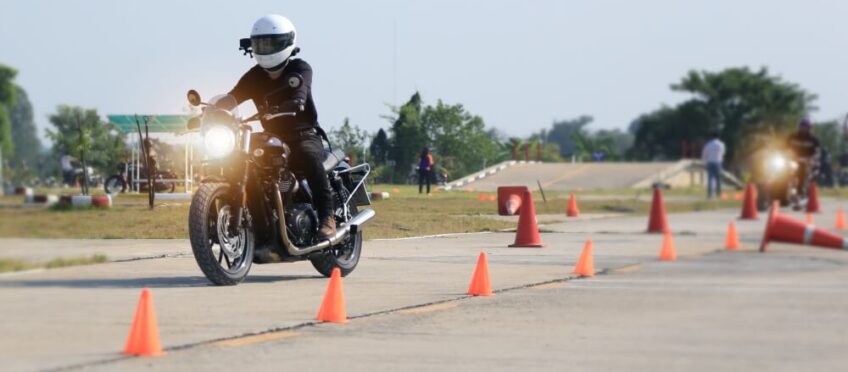Riding doesn’t have to be hazardous! Here are some tips and tricks you can take advantage of to enter the sport with confidence.
I’ve heard all the jokes around becoming a rider: “donorcycle,” and in Quebec, “mortecycle.” For years, even I delayed getting my licence because I thought the sport was very dangerous. Everyone knows a story of a rider who has been in an accident, perhaps seriously hurt, and I thought having my accident wasn’t a matter of when but rather how.
As a veteran rider, I no longer think that. I won’t say riding is as safe as driving a car, the statistics speak for themselves, but there are several things you can do that can minimize the risks of riding significantly. Here are my five essentials to staying safe, whether you are a new or experienced rider.
Do a Training Course
Riding is like any other skill, you can learn it either through trial and error or through some guided instruction. In this case, you’ll probably want to learn using the latter method. In some provinces completing a certified motorcycle course is mandatory to get your motorcycle licence. I learned a ton of core skills from my courses when I first started; they consisted of 6 hours of theory and 26 hours of practice, including 16 hours of closed-track training and 10 hours of guided road practice.
We learned everything, from the correct way to get on and off the bike, to throttle control, clutch control, counter-balancing, counter-steering, target fixation, emergency avoidance, and emergency braking. And yes, we inevitably learned how to pick up the bike correctly without damaging your back. By the time I did my learner’s test, I was a pretty confident rider with a solid foundation of the essentials, and I was beginning to develop some muscle memory too. Doing a course like this apparently grants you the equivalent of about two years of riding experience, and more importantly, gets you safely through that critical newbie period when the majority of accidents occur. It is no wonder completing a riding course fast-tracks the licencing process in Ontario.
Choose the Right Bike
If you look at motorcycle mortality statistics, most deaths are among young men. Young men are looking for power these days and will find it in action movies, guns, games… or engines. Take the 2022 Panigale’s V4, for example – it delivers 215.5 hp (158.5 kW) at 13,000 rpm; that’s a lot of power to control your first time out!
In Europe and some provinces in Canada, you have to start on a small bike and work up to a big one. In the EU for example, if you are under 18 you must start with an A1 license that allows you to ride a bike with up to 14.75 ponies. That’s a scooter, moped, or a “real” motorcycle up to approximately 125cc in size. (The size of the engine is less crucial than the power-to-weight ratio, but we’ll stick with cc numbers for simplicity’s sake.) If you are 18, you can start with an A2 Restricted License and a bike in the 250 to 500cc range. After two years, you can graduate with a full A1 license with no power restrictions. It’s a little more complicated than how I’ve summarized, but the idea is that you start on a small bike and after a certain amount of experience, you can ride a more powerful bike. This makes a lot of sense to me since it’s the weight and power you must learn to control when getting into motorcycle riding.
If you are shopping for your first ride, do you really want to start on a litre bike? Don’t listen to the argument that you will “outgrow” a smaller bike – that’s the point. I suggest starting on a bike no bigger than 650cc in size, in fact, even smaller could be better. There’s nothing wrong with a fun little 250 for your first few years of riding.
Ride With a Club, At Least For Your First Year
There are many benefits to riding with a club, but a key one is that you will be riding with experienced motorcyclists who know how fast to take a corner, how to adjust their riding in rain or after dark, when to take a break, and generally how to stay safe. According to the Hurt Report, the most comprehensive study yet on motorcycle fatalities, over half of all accidents happen within the first five months of riding. Needless to say, my club got me safely through the most critical period of learning. On that note, another big plus to club riding is that you become more visible to drivers while out on the road. Some informal coaching occurs off the bikes too, and as an added benefit, you develop friendships that can last a lifetime.
Get the Right Gear
Quick quiz: looking at the riders pictured above, which catches your eye first? The reflective ones, duh! I like what Clinton Smout says about this: it’s not loud pipes that save lives but loud colours. It doesn’t take much to catch the eye – in the photo above for example, I’m wearing a single high-visibility velcro armband and my other jacket has high-visibility zippers as well as minor accents. You don’t need your jacket to be the equivalent of leaning on the horn when a little “beep-beep” will get attention just the same.
Want to wear that classic black leather jacket? Go ahead, but consider some colour in your helmet. Want to wear a black helmet too? Get some auxiliary lighting to increase your visibility. Don’t want to get aux lighting because it cramps your style? At least flash your high beam as you approach an intersection if you are not sure that the driver turning left can see you. When the majority of multi-vehicle accidents are caused by not being seen, anything you can do to increase your visibility will help.
According to data collected by Dietmar Otte and cited in Proficient Motorcycling (Hough 38), as much as one-third of impacts on the helmet are on the chin bar, so a full-face helmet provides significantly more protection than an open-face helmet. After you’ve protected your head, you might also consider protecting the next most vulnerable part of your body—your neck. A few years ago, I started wearing a neck brace. It sits on my shoulders and obstructs the helmet on impact from being pushed beyond the limits of my neck. An independent study found that a neck brace significantly reduces the probability of serious neck trauma. It’s comfortable and once I put it on, I forget that it’s there. I’m confident that, in time, neck braces will become as common as helmets and will perhaps even become required in select regions in North America. If you want the most protection possible, consider an air vest. This technology is developing rapidly today in terms of improved ease of use and cost. I suspect that they too will soon become the norm, just as airbags have become required in all automobiles since 1998.
Have the Right Attitude
I’ve been driving a car for 40 years and have never had even a fender-bender (knock on wood). There’s more to this boast than skill – it’s mostly a product of awareness of my environment and the ability to anticipate problems before they occur. Part of it is also not pushing my limits in any dangerous way; you have to save a little buffer while riding, say 15%, for the unexpected.
For me, having the right attitude is listening to my body when it gets tired, and sometimes it’s listening to my gut when it knows I’m heading into danger. My dad used to say his stomach told him he was speeding before the speedometer did. I know a guy who uses a mantra to enter the right frame of mind as he gets ready to ride: as he pulls on his helmet, he thinks to himself, “Everyone wants to kill me.”
My wife did a little riding with me this past summer; I don’t push it with her on the back, not only because of the, eh hem, extra weight that affects the bike’s dynamics, but also because I figure a pillion is already nervous; there’s no need to ride like an idiot to impress. I’m not saying you can eliminate all risk—there’s always bad luck—but how much risk you want to take on in a given day is literally in the palm of your (right) hand.
There’s a clear pathway to entering the sport safely and staying safe: do a course, get the right bike, join a club, buy the gear, and adopt the right attitude. I no longer believe that a crash is inevitable for me, although the risk is certainly a part of riding that we have to manage. That being said, there’s risk in not doing what your heart desires too, whatever that may be. Riding a motorcycle has become a major passion for me and has brought me many hours of joy, so if you’ve always wanted to ride, go ahead and get a bike! Just remember to do it the right way during those crucial beginner stages.










join the conversation